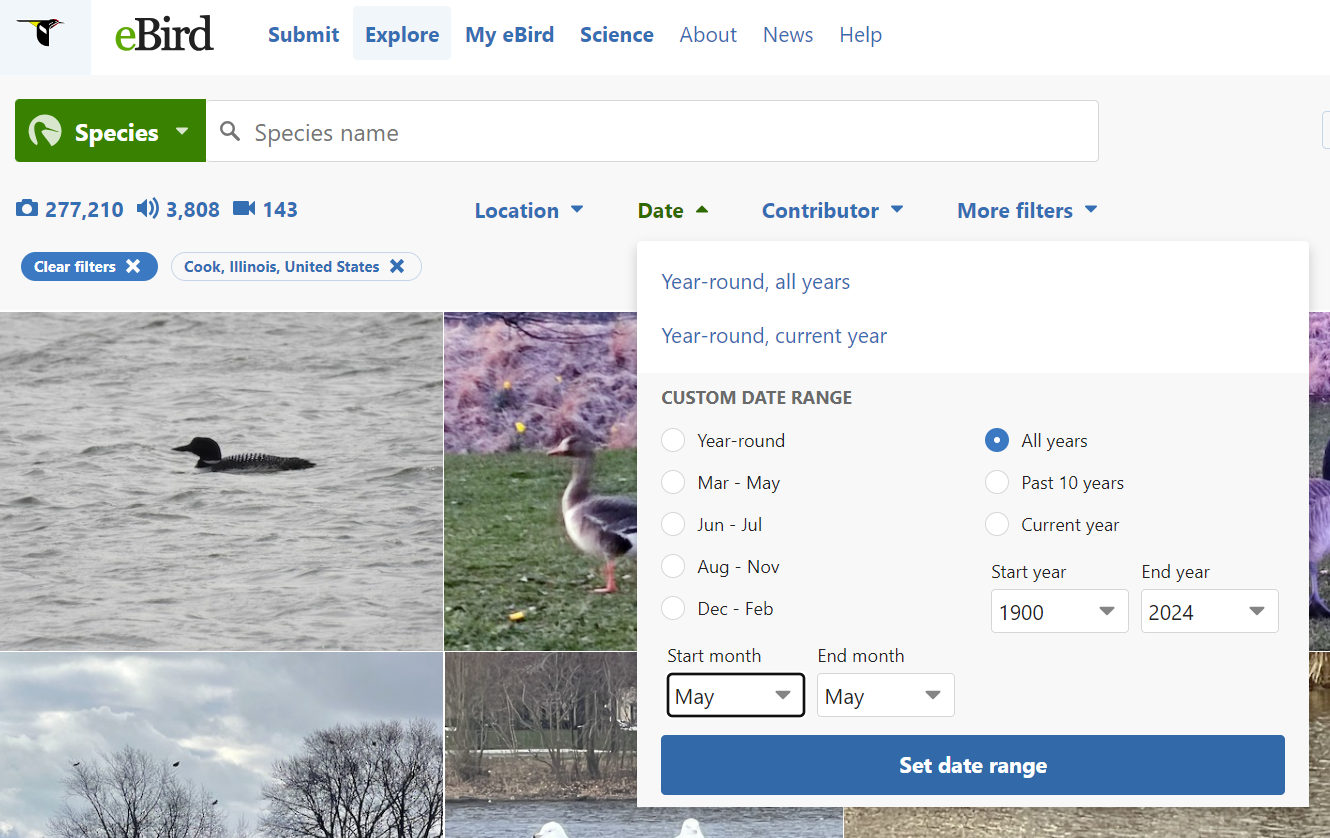Many of us know eBird as the app from the Cornell Lab of Ornithology that makes listing and sharing our bird observations easy. The eBird website also features useful information and ways to explore data: interactive maps, species profiles, and tools for analyzing sightings across years and geographic regions. But you may not know there are even more tools available to help you learn about birds. Below I’m going to highlight a couple of lesser-known features available on the website version of eBird that might help you learn and study birds before we see all those spring migrants, or help you study before taking a trip somewhere
#1 Photo + Sound Quiz
The first tool I want to highlight is the “Photo + Sound Quiz,” which can be found by navigating to the “Explore” page of eBird and then scrolling down to the bottom.
The link to the “Explore” section is at the top of the eBird website.
You will find the “Photo + Sound Quiz,” at the bottom right of the “Explore” page.
eBird’s own description of the quiz tool gives you all the important details, “Each custom quiz presents you with 20 birds that occur at a date and location of your choosing, pulled from millions of photos and sounds added to the Macaulay Library by eBirders around the world. Guess the species—and don't worry if you're wrong—this challenging quiz is for your own fun and learning. After each guess, you'll rate the photo or sound for its quality, helping curate the Macaulay Library so it is more useful for you and for science.”
I can’t recommend this tool enough, as it’s incredibly useful for studying birds before each season or before visiting a new area–anywhere in the world! For a free tool, you won’t find anything better and all they ask in return is for you to rate each photo on a scale of 1 to 5 stars. You also have the option of generating quizzes based on likely birds versus infrequent or “any possible bird” from an area, which is a very helpful stepwise approach for easing into learning new birds.
There are many ways to customize your quiz before you start.
From eBird.org, “Each custom quiz presents you with 20 birds that occur at a date and location of your choosing, pulled from millions of photos and sounds added to the Macaulay Library by eBirders around the world.”
#2 Search Photos and Sounds
Another tool I find helpful is searching through the Macaulay Library (which is the repository for all media submitted to eBird). If you scroll back up to the middle of the “Explore” page you’ll find “Search Photos and Sounds” which gives you access to all the media ever uploaded to eBird/Macaulay Library.
From the ”Explore” page, navigate to the center section to find “Search Photos and Sounds.”
Once you’re on this page, you will see an array of drop-down filter options to narrow down what you want to explore. I’ll highlight a couple of ways to use this feature for studying birds, but there are many options for exploring this database.
One way to use this tool is to simply search for a species you are interested in, e.g. type in “Scarlet Tanager,” and see all the different photos and sounds of that species. This is a great way to study plumage differences between males and females or to study all the different molts that a species might go through seasonally, or at different ages–think of gulls as one example.
Use the “Search Photos and Sounds” to explore media of one species such as “Scarlet Tanager”
Another way to use this tool is to filter by location and date instead of by a specific species. Filtering by location is a great way to give yourself an idea of what birds you might see before visiting a certain location. The power of a tool like eBird, and consequently this media library, is that you can filter locations at many different scales, e.g., you can choose a whole state or country, a county within a state, or down to a specific eBird hotspot.
Use the “Search Photos and Sounds” to explore media by location.
Use the “Search Photos and Sounds” to explore media by location and date. *Note, as you add more filters you’ll see them displayed just above the photos.
You can even choose different ways to filter the pictures at the top right, e.g. this is now filtered by “Best Quality” photos, after being filtered by location and date.
Of course, as you further peruse the “Explore” page, you’ll find ways to research what times of the year you are most likely to see certain species, ways to sign up for email alerts for particular locations, or new ways to look at the data you’ve already submitted to eBird (for me that’s 3000 checklists over 9 years). The eBird database has become not only a significant contribution to overall bird science, but also a force for citizen scientists to explore data and learn for their own educational purposes.
Follow us on our social media channels and look for opportunities to share the ways that you use eBird besides holding all your bird lists!
**NOTE: It’s important to emphasize that these features are only available through the website version of eBird. Although the app version has added some great functions in recent years, the tools highlighted are not available on the app version of eBird.










